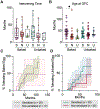Clinical Significance of Egg Sensitization in Pediatric Food Protein-Induced Enterocolitis Syndrome to Hen's Egg
- PMID: 40484346
- PMCID: PMC12302416
- DOI: 10.1016/j.jaip.2025.05.055
Clinical Significance of Egg Sensitization in Pediatric Food Protein-Induced Enterocolitis Syndrome to Hen's Egg
Abstract
Background: Hen's egg, a common IgE-mediated food allergen, is an increasingly common food protein-induced enterocolitis syndrome (FPIES) trigger. Atypical FPIES is defined as detectable IgE to the food causing FPIES.
Objective: To evaluate clinical characteristics, natural history, baked egg tolerance, and FPIES challenge outcomes based on allergic sensitization status in patients with egg FPIES.
Methods: This retrospective, dual-center cohort study examined children with the diagnosis of egg FPIES by an allergist. We reviewed charts for reaction characteristics, atopic history, allergic sensitization to egg, baked egg tolerance, and food reintroduction outcomes.
Results: Of 153 patients with FPIES, 124 underwent egg allergy testing and 56 (36.6%) were sensitized to egg. Skin testing and food reintroduction varied based on practice and patient preferences. Of 48 patients who introduced baked egg, 30 (62.5%) tolerated it after a median of 20.5 months (interquartile range, 13.25-33 months) of avoidance. Including those tolerating baked egg at presentation, 22.9% incorporated baked before unbaked egg. Sensitization did not delay tolerance but was linked to a higher risk of immediate hypersensitivity during reintroduction. IgE-mediated symptoms were evident during reintroductions in sensitized patients but were absent in non-sensitized and untested patients. The overall phenotype switch rate from FPIES to IgE food allergy was at least 9.2%. Concomitant IgE-mediated food allergy to other foods was more common among sensitized patients.
Conclusions: Our data suggest that testing for allergic sensitization to egg may help stratify patients with FPIES at risk for future IgE-mediated symptoms. Future prospective studies should evaluate the optimal timing and predictive value of skin testing in patients with FPIES and the utility of introducing baked egg in patients with egg FPIES.
Keywords: Allergic sensitization; Atypical FPIES; Baked egg tolerance; Egg allergy; Egg hypersensitivity; Food protein–induced enterocolitis syndrome; IgE-mediated food allergy.
Copyright © 2025 American Academy of Allergy, Asthma & Immunology. Published by Elsevier Inc. All rights reserved.
Conflict of interest statement
Conflicts of interest: The authors declare they have no relevant conflicts of interest.
Figures


Similar articles
-
Implementing The Food Ladder For Tolerance Acquisition In A Pediatric Case With Food Protein-Induced Enterocolitis Syndrome.J Pediatr Health Care. 2025 Jul 22:S0891-5245(25)00189-0. doi: 10.1016/j.pedhc.2025.06.010. Online ahead of print. J Pediatr Health Care. 2025. PMID: 40693989
-
Acute typical food protein-induced enterocolitis syndrome triggered by egg white: Two case reports.Allergol Immunopathol (Madr). 2025 Jul 1;53(4):141-145. doi: 10.15586/aei.v53i4.1345. eCollection 2025. Allergol Immunopathol (Madr). 2025. PMID: 40682240
-
Safety and effectiveness of milk and egg ladders in children with IgE-mediated food allergy-A case series.J Pediatr Gastroenterol Nutr. 2025 Aug;81(2):331-338. doi: 10.1002/jpn3.70088. Epub 2025 May 22. J Pediatr Gastroenterol Nutr. 2025. PMID: 40401391
-
Maternal prenatal and/or postnatal n-3 long chain polyunsaturated fatty acids (LCPUFA) supplementation for preventing allergies in early childhood.Cochrane Database Syst Rev. 2015 Jul 22;2015(7):CD010085. doi: 10.1002/14651858.CD010085.pub2. Cochrane Database Syst Rev. 2015. PMID: 26197477 Free PMC article.
-
Skin care interventions in infants for preventing eczema and food allergy.Cochrane Database Syst Rev. 2022 Nov 14;11(11):CD013534. doi: 10.1002/14651858.CD013534.pub3. Cochrane Database Syst Rev. 2022. PMID: 36373988 Free PMC article.
References
-
- Nowak-Węgrzyn A, Chehade M, Groetch ME, Spergel JM, Wood RA, Allen K, et al. International consensus guidelines for the diagnosis and management of food protein–induced enterocolitis syndrome: Executive summary—Workgroup Report of the Adverse Reactions to Foods Committee, American Academy of Allergy, Asthma & Immunology. Journal of Allergy and Clinical Immunology. 2017;139:1111–1126.e4. - PubMed
-
- Ruffner MA, Ruymann K, Barni S, Cianferoni A, Brown-Whitehorn T, Spergel JM. Food protein-induced enterocolitis syndrome: Insights from review of a large referral population. Journal of Allergy and Clinical Immunology: In Practice. 2013;1:343–9. - PubMed
-
- Baker MG, Sampson HA. Recent trends in food protein-induced enterocolitis syndrome (FPIES). J Allergy Clin Immunol. 2023;151:43–6. - PubMed
-
- Akashi M, Hayashi D, Kajita N, Kinoshita M, Ishii T, Tsumura Y, et al. Recent dramatic increase in patients with food protein-induced enterocolitis syndrome (FPIES) provoked by hen’s egg in Japan. J Allergy Clin Immunol Pract. 2022;10:1110–1112.e2. - PubMed
-
- Hua A, El-Zataari M, Hudson E, Sanders GM, Schuler CF. Evolution of Food Protein-Induced Enterocolitis Syndrome (FPIES) Index Trigger Foods and Subsequent Reactions After Initial Diagnosis. J Allergy Clin Immunol Pract. 2023;11:3179–3186.e2. - PubMed
Grants and funding
LinkOut - more resources
Full Text Sources

